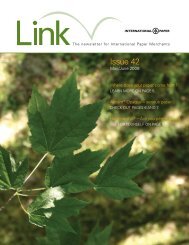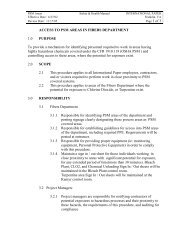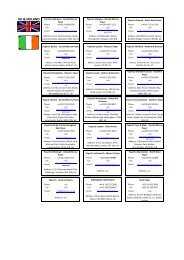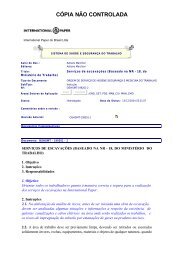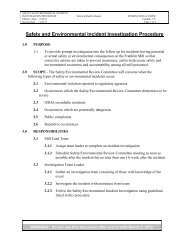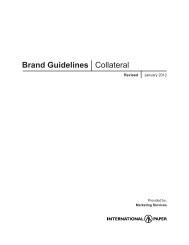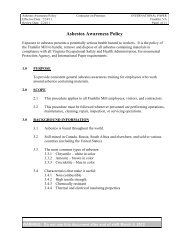Working Safety in the Heat - International Paper
Working Safety in the Heat - International Paper
Working Safety in the Heat - International Paper
You also want an ePaper? Increase the reach of your titles
YUMPU automatically turns print PDFs into web optimized ePapers that Google loves.
<strong>Work<strong>in</strong>g</strong> <strong>Safety</strong> <strong>in</strong> <strong>the</strong> <strong>Heat</strong> <strong>Safety</strong> & Health Manual INTERNATIONAL PAPER<br />
Effective Date: 11/30/11 Frankl<strong>in</strong>, VA<br />
Review Date: 11/30/11 Page 1 of 17<br />
<strong>Work<strong>in</strong>g</strong> <strong>Safety</strong> <strong>in</strong> <strong>the</strong> <strong>Heat</strong><br />
1.0 PURPOSE<br />
This policy is <strong>in</strong>tended to protect employees from potential adverse effects of<br />
overexposure to heat. This guidance document will help you to understand how <strong>the</strong><br />
body reacts <strong>in</strong> hot environments and how to recognize “heat related illnesses”, be able to<br />
use basic temperature and humidity measurements to assess heat stress risks, <strong>in</strong>troduce<br />
<strong>the</strong> more advanced heat stress measurement and assessment methods and understand<br />
how <strong>the</strong>y can be used, and know what steps to take to control <strong>the</strong> hazards of heat<br />
exposure.<br />
2.0 SCOPE<br />
It applies to all <strong>International</strong> <strong>Paper</strong> employees and contractors who work <strong>in</strong> high<br />
temperature conditions for significant time periods.<br />
3.0 EXPOSURE TO HEAT<br />
3.1 The Body’s Response to <strong>Heat</strong><br />
Your body works best when it has an <strong>in</strong>ternal “core” temperature of 98.6 °F.<br />
98.6 °F Might seem warm, but this is your <strong>in</strong>ternal temperature (not <strong>the</strong> air<br />
temperature). This temperature is necessary for your vital organs to function<br />
normally. Dur<strong>in</strong>g a regular day, your body temperature may vary by about 2 °F<br />
depend<strong>in</strong>g on <strong>the</strong> time of day, your level of physical activity and how you are<br />
feel<strong>in</strong>g (your emotional state). The body’s metabolic processes produce <strong>the</strong><br />
right amount of heat you need when you digest your food and when you perform<br />
physical activity.<br />
3.2 Ma<strong>in</strong>ta<strong>in</strong><strong>in</strong>g Balance<br />
When you work <strong>in</strong> extreme hot temperatures, your body has to adapt. To<br />
ma<strong>in</strong>ta<strong>in</strong> a constant <strong>in</strong>ner body temperature, <strong>the</strong> body must cont<strong>in</strong>ually lose heat<br />
<strong>in</strong> hot environments.<br />
3.3 To Stay Cool <strong>in</strong> Hot Environments, <strong>the</strong> Body;<br />
� Sweats – evaporat<strong>in</strong>g sweat cools <strong>the</strong> body, and<br />
� Increases blood flow to <strong>the</strong> sk<strong>in</strong> – to speed up <strong>the</strong> loss of heat from <strong>the</strong> sk<strong>in</strong><br />
(radiate away <strong>the</strong> excess heat) if <strong>the</strong> outside air is cooler.<br />
By sweat<strong>in</strong>g and chang<strong>in</strong>g <strong>the</strong> rate of blood flow, <strong>the</strong> body can adapt to a fairly<br />
wide range of hot temperatures. However, <strong>the</strong>re are limits to what <strong>the</strong> body can<br />
WARNING: Do not use this document after end of shift March 5, 2012
<strong>Work<strong>in</strong>g</strong> <strong>Safety</strong> <strong>in</strong> <strong>the</strong> <strong>Heat</strong> <strong>Safety</strong> & Health Manual INTERNATIONAL PAPER<br />
Effective Date: 11/30/11 Frankl<strong>in</strong>, VA<br />
Review Date: 11/30/11 Page 2 of 17<br />
adapt to and its ability to ma<strong>in</strong>ta<strong>in</strong> its core temperature can fail.<br />
3.3.1 Acclimatization<br />
4.0 THERMAL COMFORT<br />
People can adapt to hotter temperatures through a process called<br />
“acclimatization.” At <strong>the</strong> workplace, acclimatization is important<br />
because it allows you to work more safely and efficiently. However,<br />
becom<strong>in</strong>g acclimatized takes time.<br />
When work<strong>in</strong>g <strong>in</strong> hot conditions, people need at least 4 to 7 work<strong>in</strong>g<br />
days to become fully acclimatized, but <strong>the</strong> process may take up to three<br />
weeks. As such, a gradual <strong>in</strong>troduction to heat or implement<strong>in</strong>g an<br />
acclimatization scheduled is recommended. For example, do<strong>in</strong>g physical<br />
work for less than a full work<strong>in</strong>g day on <strong>the</strong> first hot day and slowly<br />
<strong>in</strong>creas<strong>in</strong>g <strong>the</strong> time spent work<strong>in</strong>g over <strong>the</strong> next week.<br />
“Thermal comfort” refers to whe<strong>the</strong>r a person feels comfortable <strong>in</strong> hot environments. Thermal<br />
comfort is very important. Ideally, air temperature should be kept with<strong>in</strong> a range that most<br />
people f<strong>in</strong>d comfortable. The season, relative humidity, cloth<strong>in</strong>g and activity level of build<strong>in</strong>g<br />
occupants may factor <strong>in</strong>to <strong>the</strong> comfort zone. In summer, temperatures of 73-82°F are<br />
recommended, while <strong>in</strong> <strong>the</strong> w<strong>in</strong>ter when relative humidity is closer to 30%, recommended<br />
temperatures are from 68 - 77°F.<br />
4.1 Factors Affect<strong>in</strong>g How Hot You Feel:<br />
4.1.1 Air temperature – Air temperature is what can be measured with a<br />
<strong>the</strong>rmometer. However, <strong>in</strong> situations where <strong>the</strong>re is a lot of radiant heat<br />
(see below for examples) it is not always an accurate <strong>in</strong>dication of how<br />
hot you feel.<br />
4.1.2 O<strong>the</strong>r sources of heat (radiant heat). These sources can <strong>in</strong>clude direct<br />
sunlight, mach<strong>in</strong>ery that generates heat, hot water, heaters or open flames,<br />
asphalt, etc. Over time on a hot day, <strong>the</strong>se sources can radiate heat <strong>in</strong>to<br />
<strong>the</strong> air and add to <strong>the</strong> amount of heat you “feel”.<br />
4.1.3 Relative humidity is <strong>the</strong> amount of moisture (water) <strong>in</strong> <strong>the</strong> air. The<br />
warmer <strong>the</strong> air, <strong>the</strong> more moisture it can hold. High humidity makes<br />
people feel hotter because sweat does not evaporate off <strong>the</strong> sk<strong>in</strong> (it is <strong>the</strong><br />
evaporation of sweat that makes you feel cooler).<br />
4.1.4 Mov<strong>in</strong>g air (speed) usually cools a person. This cool<strong>in</strong>g provides relief <strong>in</strong><br />
a hot environment as long as <strong>the</strong> mov<strong>in</strong>g air is cooler than <strong>the</strong> person<br />
(less than 98.6°F.<br />
WARNING: Do not use this document after end of shift March 5, 2012
<strong>Work<strong>in</strong>g</strong> <strong>Safety</strong> <strong>in</strong> <strong>the</strong> <strong>Heat</strong> <strong>Safety</strong> & Health Manual INTERNATIONAL PAPER<br />
Effective Date: 11/30/11 Frankl<strong>in</strong>, VA<br />
Review Date: 11/30/11 Page 3 of 17<br />
4.1.5 Physical exertion (how hard you are work<strong>in</strong>g) also <strong>in</strong>fluences how hot<br />
you feel. Mov<strong>in</strong>g around or work<strong>in</strong>g generates heat. When work<strong>in</strong>g on a<br />
very hot day, this movement <strong>in</strong>creases your heat stress.<br />
4.2 O<strong>the</strong>r Factors<br />
4.2.1 A person’s general health also <strong>in</strong>fluences how well <strong>the</strong> person adapts to<br />
heat. Those with extra weight often have trouble <strong>in</strong> hot situations due to<br />
<strong>the</strong> body hav<strong>in</strong>g difficulty ma<strong>in</strong>ta<strong>in</strong><strong>in</strong>g a good heat balance. Age<br />
(particularly for people about 45 years and older), poor general health,<br />
and a low level of fitness will make people more susceptible to feel<strong>in</strong>g <strong>the</strong><br />
extremes of heat.<br />
4.2.2 Medical conditions can also <strong>in</strong>crease how susceptible <strong>the</strong> body is to heat.<br />
People with heart disease, high blood pressure, respiratory disease and<br />
uncontrolled diabetes may need to take special precautions.<br />
4.2.3 In addition, people with sk<strong>in</strong> diseases and rashes may be more<br />
susceptible to heat. Substances – both prescription or o<strong>the</strong>rwise – can also<br />
have an impact on how people react to heat.<br />
4.3 Human Variability<br />
Variability between people - different metabolic rates, levels of physical fitness,<br />
medical conditions (<strong>in</strong>clud<strong>in</strong>g medication), acclimatization, level of hydration,<br />
age, smok<strong>in</strong>g, etc. makes achiev<strong>in</strong>g <strong>the</strong>rmal comfort a challenge. These factors<br />
all affect how people perceive <strong>the</strong>ir comfort levels, even if <strong>the</strong>y are do<strong>in</strong>g <strong>the</strong><br />
same work <strong>in</strong> <strong>the</strong> same environment.<br />
5.0 HEAT RELATED ILLNESS<br />
Serious health issues can result when you are exposed to extremes of heat.<br />
5.1 <strong>Heat</strong> stress is <strong>the</strong> overall heat load on <strong>the</strong> body, <strong>in</strong>clud<strong>in</strong>g environmental heat and<br />
<strong>in</strong>ner body heat production due to work<strong>in</strong>g hard. Mild or moderate heat stress may<br />
be uncomfortable and may affect performance and safety, but it is not usually<br />
harmful to your health. When heat stress is more extreme, <strong>the</strong> possible health effects<br />
or heat-related illnesses <strong>in</strong>clude:<br />
5.1.1 <strong>Heat</strong> edema is swell<strong>in</strong>g which generally occurs among people who are<br />
not acclimatized to work<strong>in</strong>g <strong>in</strong> hot conditions. Swell<strong>in</strong>g is often most<br />
noticeable <strong>in</strong> <strong>the</strong> ankles.<br />
5.1.2 <strong>Heat</strong> rashes are t<strong>in</strong>y red spots on <strong>the</strong> sk<strong>in</strong>, which cause a prickl<strong>in</strong>g<br />
sensation. The spots are <strong>the</strong> result of <strong>in</strong>flammation caused when sweat<br />
glands become plugged.<br />
5.1.3 <strong>Heat</strong> cramps are sharp pa<strong>in</strong>s <strong>in</strong> <strong>the</strong> muscles that may occur alone or be<br />
comb<strong>in</strong>ed with one of <strong>the</strong> o<strong>the</strong>r heat stress disorders. The cause is salt<br />
WARNING: Do not use this document after end of shift March 5, 2012
<strong>Work<strong>in</strong>g</strong> <strong>Safety</strong> <strong>in</strong> <strong>the</strong> <strong>Heat</strong> <strong>Safety</strong> & Health Manual INTERNATIONAL PAPER<br />
Effective Date: 11/30/11 Frankl<strong>in</strong>, VA<br />
Review Date: 11/30/11 Page 4 of 17<br />
imbalance result<strong>in</strong>g from <strong>the</strong> failure to replace salt lost with sweat.<br />
Cramps most often occur when people dr<strong>in</strong>k large amounts of water<br />
without sufficient salt (electrolyte) replacement.<br />
5.1.4 <strong>Heat</strong> exhaustion is caused by excessive loss of water and salt.<br />
Symptoms <strong>in</strong>clude heavy sweat<strong>in</strong>g, weakness, dizz<strong>in</strong>ess, nausea,<br />
headache, diarrhea, muscle cramps, and more (see table 2).<br />
5.1.5 <strong>Heat</strong> syncope is heat-<strong>in</strong>duced gidd<strong>in</strong>ess and fa<strong>in</strong>t<strong>in</strong>g <strong>in</strong>duced by<br />
temporarily <strong>in</strong>sufficient flow of blood to <strong>the</strong> bra<strong>in</strong> while a person is<br />
stand<strong>in</strong>g. It occurs mostly among unacclimatized people. It is caused by<br />
<strong>the</strong> loss of body fluids through sweat<strong>in</strong>g, and by lowered blood pressure<br />
due to pool<strong>in</strong>g of blood <strong>in</strong> <strong>the</strong> legs.<br />
5.1.6 <strong>Heat</strong> stroke and hyperpyrexia (elevated body temperature) are <strong>the</strong> most<br />
serious types of heat illnesses. Signs of heat stroke <strong>in</strong>clude body<br />
temperature often greater than 106°F, and complete or partial loss of<br />
consciousness. The signs of heat hyperpyrexia are similar except that <strong>the</strong><br />
sk<strong>in</strong> rema<strong>in</strong>s moist. Sweat<strong>in</strong>g is not a good symptom of heat stress as<br />
<strong>the</strong>re are two types of heat stroke – “classical” where <strong>the</strong>re is little or no<br />
sweat<strong>in</strong>g (usually occurs <strong>in</strong> children, persons who are chronically ill, and<br />
<strong>the</strong> elderly), and “exertional” where body temperature rises because of<br />
strenuous exercise or work and sweat<strong>in</strong>g is usually present.<br />
5.2 Long Term (Chronic) Illnesses From <strong>Heat</strong> Exposure<br />
Some research has shown that certa<strong>in</strong> disorders of <strong>the</strong> kidney, liver, heart,<br />
digestive system, central nervous system and sk<strong>in</strong> may be l<strong>in</strong>ked to heat<br />
exposure. However, <strong>the</strong>re is no conclusive scientific evidence l<strong>in</strong>k<strong>in</strong>g such<br />
effects and long-term exposure to heat. The exception is damage to <strong>the</strong> eye, <strong>in</strong><br />
particular <strong>the</strong> lens, from radiant heat and <strong>in</strong>frared radiation. Occupations at risk<br />
for eye damage <strong>in</strong>clude glass manufactur<strong>in</strong>g, foundries, ceramics, bakeries, and<br />
outdoor activities <strong>in</strong> brilliant sunsh<strong>in</strong>e without sunglasses (particularly at high<br />
elevations). O<strong>the</strong>r probable health effects that have been reported <strong>in</strong>clude<br />
chronic heat exhaustion, sleep disturbances, and susceptibility to m<strong>in</strong>or <strong>in</strong>juries.<br />
5.3 Effects on Physical and Cognitive Performance<br />
5.3.1 <strong>Work<strong>in</strong>g</strong> <strong>in</strong> <strong>the</strong> heat can have both mental and physical effects. These<br />
<strong>in</strong>clude:<br />
5.3.1.1 Mental Changes – <strong>in</strong>creased irritation, mood changes,<br />
depression, aggression, and anger.<br />
5.3.1.2 Physical Responses – <strong>in</strong>creased heart rate, <strong>in</strong>creased sweat<strong>in</strong>g,<br />
muscle cramps, changes <strong>in</strong> breath<strong>in</strong>g patterns, dizz<strong>in</strong>ess,<br />
WARNING: Do not use this document after end of shift March 5, 2012
<strong>Work<strong>in</strong>g</strong> <strong>Safety</strong> <strong>in</strong> <strong>the</strong> <strong>Heat</strong> <strong>Safety</strong> & Health Manual INTERNATIONAL PAPER<br />
Effective Date: 11/30/11 Frankl<strong>in</strong>, VA<br />
Review Date: 11/30/11 Page 5 of 17<br />
fa<strong>in</strong>tness, or “prickly heat” (heat rash).<br />
5.3.2 The comb<strong>in</strong>ation of heat stress and dehydration means that people<br />
perform<strong>in</strong>g skilled tasks may become tired faster than normal, and have<br />
trouble concentrat<strong>in</strong>g. There is a higher risk of errors <strong>in</strong> this situation.<br />
Aside from health effects, <strong>the</strong> U.S. National Institute for Occupational<br />
<strong>Safety</strong> and Health (NIOSH) reports that <strong>the</strong> frequency of accidents, <strong>in</strong><br />
general, appears to be higher <strong>in</strong> hot environments. <strong>Work<strong>in</strong>g</strong> <strong>in</strong> a hot<br />
environment can lower <strong>the</strong> mental alertness and physical performance of<br />
an <strong>in</strong>dividual. Increased body temperature and physical discomfort<br />
promote irritability, anger, and o<strong>the</strong>r emotional states that sometimes<br />
cause workers to overlook safety procedures or to divert <strong>the</strong>ir attention<br />
from hazardous tasks,<br />
5.3.3 <strong>Heat</strong> can contribute to accidents <strong>in</strong> o<strong>the</strong>r ways such as <strong>the</strong> slipper<strong>in</strong>ess of<br />
sweaty palms, dizz<strong>in</strong>ess, <strong>the</strong> fogg<strong>in</strong>g of safety glasses or respirator<br />
facepieces, or trouble concentrat<strong>in</strong>g. Wherever <strong>the</strong>re are hot surfaces<br />
(<strong>in</strong>clud<strong>in</strong>g those heated by <strong>the</strong> sun), <strong>the</strong>re is a possibility of burns from<br />
contact.<br />
5.3.4 Watch for signs of “unusual -umbles” <strong>in</strong> yourself and your coworkers…stumbles,<br />
mumbles, fumbles and grumbles. These are warn<strong>in</strong>g<br />
signs, along with <strong>the</strong> o<strong>the</strong>r signs discussed; that <strong>the</strong> <strong>in</strong>dividual is not<br />
cop<strong>in</strong>g well with <strong>the</strong> temperature and <strong>the</strong>ir condition should be<br />
<strong>in</strong>vestigated fur<strong>the</strong>r.<br />
EHS, <strong>in</strong> Conjunction with Supervisory Staff and Employee Representative (if any),<br />
Will:<br />
• Provide assistance <strong>in</strong> <strong>the</strong> development of safe work procedures<br />
• Provide assistance <strong>in</strong> <strong>the</strong> provision of <strong>in</strong>formation sessions<br />
• Prepare <strong>in</strong>formation related to heat stress<br />
• Address heat stress concerns of workers<br />
• Make recommendations dur<strong>in</strong>g <strong>the</strong> development of or on <strong>the</strong> improvement of<br />
exist<strong>in</strong>g safe work procedures, as needed<br />
6.0 TREATMENT AND PREVENTION<br />
Be<strong>in</strong>g aware of <strong>the</strong> signs of heat stress is <strong>the</strong> first step for prevention. Remember that<br />
lack of acclimatization, poor levels of physical fitness, and conditions such as diarrhea<br />
or fever <strong>in</strong>crease susceptibility to heat stress because <strong>the</strong> body is already <strong>in</strong> a weakened<br />
state. Certa<strong>in</strong> drugs such as tranquilizers and diuretics can also <strong>in</strong>crease susceptibility.<br />
<strong>Heat</strong> stroke occurs more easily when <strong>the</strong> body has suffered a previous heat disorder.<br />
6.1 <strong>Heat</strong> stroke and hyperpyrexia require immediate first aid and medical attention.<br />
Delayed treatment may result <strong>in</strong> damage to <strong>the</strong> bra<strong>in</strong>, kidneys and heart.<br />
WARNING: Do not use this document after end of shift March 5, 2012
<strong>Work<strong>in</strong>g</strong> <strong>Safety</strong> <strong>in</strong> <strong>the</strong> <strong>Heat</strong> <strong>Safety</strong> & Health Manual INTERNATIONAL PAPER<br />
Effective Date: 11/30/11 Frankl<strong>in</strong>, VA<br />
Review Date: 11/30/11 Page 6 of 17<br />
6.1.1 A heat stroke victim is usually unable to recognize <strong>the</strong> heat stroke signs<br />
and symptoms. His or her survival depends on a co-worker’s ability to<br />
recognize <strong>the</strong> symptoms and seek immediate medical help.<br />
6.1.2 If one person is show<strong>in</strong>g signs of heat stress, take it as a sign that o<strong>the</strong>r<br />
workers may also be affected. Workers should report to a cool area and<br />
be assessed <strong>in</strong>dividually before work cont<strong>in</strong>ues.<br />
6.2 First Aid for <strong>Heat</strong> Exposure<br />
6.2.1 Get medical help, or br<strong>in</strong>g <strong>the</strong> person to a medical facility.<br />
6.2.2 Move <strong>the</strong> person to a cooler area where <strong>the</strong>y can rest (such as an airconditioned<br />
build<strong>in</strong>g or vehicle, or <strong>in</strong>to <strong>the</strong> shade)<br />
6.2.3 Take off excess cloth<strong>in</strong>g (hard hat, boots, shirt, coveralls, etc.)<br />
6.2.4 Give <strong>the</strong> person water to dr<strong>in</strong>k (only if <strong>the</strong>y are able to dr<strong>in</strong>k it on <strong>the</strong>ir<br />
own)<br />
6.2.5 Cool <strong>the</strong> person with cold compresses and rapid fann<strong>in</strong>g<br />
6.2.6 For heat cramps/heat exhaustion, take <strong>the</strong> person to a cooler place and<br />
have <strong>the</strong>m rest <strong>in</strong> a comfortable position. Give a half glass of cool<br />
water every 15 m<strong>in</strong>utes. Do not let <strong>the</strong> person dr<strong>in</strong>k too quickly. Do<br />
not give liquids with alcohol or caffe<strong>in</strong>e as <strong>the</strong>se <strong>in</strong>gredients can make<br />
conditions worse. Remove or loosen tight cloth<strong>in</strong>g and apply cool, wet<br />
cloths such as towels or wet sheets.<br />
6.2.7 While gett<strong>in</strong>g help, you can;<br />
6.2.7.1 Move <strong>the</strong> person to a cooler place. Keep <strong>the</strong> person ly<strong>in</strong>g down.<br />
6.2.7.2 If <strong>the</strong> person is conscious, have <strong>the</strong>m dr<strong>in</strong>k cool water slowly but<br />
regularly.<br />
6.2.7.3 If possible, help <strong>the</strong> person’s body cool faster by wrapp<strong>in</strong>g wet<br />
sheets around <strong>the</strong> body and <strong>the</strong>n fann<strong>in</strong>g <strong>the</strong> body.<br />
6.2.7.4 If ice packs or cold packs are available, wrap <strong>the</strong> packs <strong>in</strong> a cloth<br />
and place <strong>the</strong>m on each of <strong>the</strong> victim's wrists and ankles, <strong>in</strong> <strong>the</strong><br />
armpits, and on <strong>the</strong> neck to cool <strong>the</strong> large blood vessels.<br />
6.2.7.5 NOTE: Immers<strong>in</strong>g <strong>the</strong> victim <strong>in</strong> cold water more efficiently cools<br />
<strong>the</strong> body but it can result <strong>in</strong> harmful overcool<strong>in</strong>g. This can<br />
<strong>in</strong>terfere with vital bra<strong>in</strong> functions so it must only be done under<br />
close medical supervision. Do not use rubb<strong>in</strong>g alcohol because<br />
it closes <strong>the</strong> sk<strong>in</strong>'s pores and prevents heat loss.<br />
6.2.7.6 Watch for signals of breath<strong>in</strong>g problems and make sure <strong>the</strong><br />
airway is clear.<br />
7.0 WHAT AND WHEN TO DRINK<br />
7.1 How do you know if you are dehydrated?<br />
WARNING: Do not use this document after end of shift March 5, 2012
<strong>Work<strong>in</strong>g</strong> <strong>Safety</strong> <strong>in</strong> <strong>the</strong> <strong>Heat</strong> <strong>Safety</strong> & Health Manual INTERNATIONAL PAPER<br />
Effective Date: 11/30/11 Frankl<strong>in</strong>, VA<br />
Review Date: 11/30/11 Page 7 of 17<br />
7.1.1 Be<strong>in</strong>g dehydrated is a serious issue. S<strong>in</strong>ce you cannot rely on “feel<strong>in</strong>g<br />
thirsty”, watch for signs of fatigue, irritability, headaches, nausea, and<br />
gidd<strong>in</strong>ess. The cl<strong>in</strong>ical (medical) signs are not pass<strong>in</strong>g ur<strong>in</strong>e and changes<br />
to a person’s personality or mental state. When dehydrated, ur<strong>in</strong>e will be<br />
dark yellow to orange <strong>in</strong> color and <strong>the</strong>re will be far less of it. Unacclimatized<br />
workers can lose up to 5 or 6 quarts of fluid <strong>in</strong> an 8- hour<br />
shift.<br />
7.1.2 While work<strong>in</strong>g, dr<strong>in</strong>k about 1 cup of water every 15-20 m<strong>in</strong>utes. Workers<br />
should be well hydrated before work <strong>in</strong> <strong>the</strong> heat beg<strong>in</strong>s. A person<br />
work<strong>in</strong>g <strong>in</strong> a hot environment loses water and salt through sweat. On<br />
average, about one liter of water each hour must be drunk to replace<br />
lost fluid. Workers <strong>in</strong> hot environments should be encouraged to<br />
dr<strong>in</strong>k water even if <strong>the</strong>y do not feel thirsty. A person is adequately<br />
hydrated when <strong>the</strong> person has to ur<strong>in</strong>ate slightly more often than usual.<br />
Make sure plenty of cool dr<strong>in</strong>k<strong>in</strong>g water is available at <strong>the</strong> worksite.<br />
7.1.3 Salt Supplements<br />
7.1.3.1 An acclimatized worker loses relatively little salt <strong>in</strong> <strong>the</strong>ir sweat<br />
and, <strong>the</strong>refore, salt <strong>in</strong> <strong>the</strong> normal diet is usually enough to<br />
ma<strong>in</strong>ta<strong>in</strong> <strong>the</strong> electrolyte balance <strong>in</strong> body fluids. For unacclimatized<br />
workers who may sweat cont<strong>in</strong>uously and<br />
repeatedly, additional salt <strong>in</strong> <strong>the</strong> food may be used.<br />
7.1.3.2 In most cases, people will eat enough salt to ma<strong>in</strong>ta<strong>in</strong> <strong>the</strong>ir<br />
electrolyte balance. Salt tablets are not recommended because<br />
<strong>the</strong> salt does not enter <strong>the</strong> body system as fast as water or o<strong>the</strong>r<br />
fluids. Too much salt can cause higher body temperatures,<br />
<strong>in</strong>creased thirst and nausea. Workers on salt-restricted diets<br />
should discuss <strong>the</strong>ir job tasks and <strong>the</strong> need for supplementary salt<br />
with <strong>the</strong>ir doctor.<br />
7.1.4 Sport Dr<strong>in</strong>ks, Fruit Juice, Etc<br />
7.1.4.1 Dr<strong>in</strong>ks specially designed to replace body fluids and electrolytes<br />
may be taken but for most people, <strong>the</strong>y should be used <strong>in</strong><br />
moderation. They may be of benefit for workers who have very<br />
physically active occupations but keep <strong>in</strong> m<strong>in</strong>d <strong>the</strong>y may add<br />
unnecessary sugar or salt to your diet. Fruit juice or sport and<br />
electrolyte dr<strong>in</strong>ks, diluted to half <strong>the</strong> strength with water, is an<br />
option. Dr<strong>in</strong>ks with alcohol or caffe<strong>in</strong>e should never be taken, as<br />
<strong>the</strong>y dehydrate <strong>the</strong> body. For most people water is <strong>the</strong> most<br />
WARNING: Do not use this document after end of shift March 5, 2012
<strong>Work<strong>in</strong>g</strong> <strong>Safety</strong> <strong>in</strong> <strong>the</strong> <strong>Heat</strong> <strong>Safety</strong> & Health Manual INTERNATIONAL PAPER<br />
Effective Date: 11/30/11 Frankl<strong>in</strong>, VA<br />
Review Date: 11/30/11 Page 8 of 17<br />
efficient fluid for re-hydration.<br />
8.0 RESPONSIBILITES<br />
8.1 Managers Will:<br />
• Identify jobs with a potential risk of heat stress and develop job-specific safe work<br />
practices which address this hazard<br />
• Inform workers and <strong>the</strong>ir supervisors where <strong>the</strong>ir work <strong>in</strong>volves potential risk of heat<br />
stress<br />
• Develop a process to ensure supervisors and workers are advised of: factors which<br />
can predispose <strong>the</strong>m to heat stress <strong>the</strong> warn<strong>in</strong>g signs and symptoms of heat<br />
stress conditions (heat rash, heat cramps, heat exhaustion and heat stroke), and <strong>the</strong><br />
measures to be taken to protect aga<strong>in</strong>st this hazard (e.g. hav<strong>in</strong>g water available to<br />
dr<strong>in</strong>k dur<strong>in</strong>g work shift, wear<strong>in</strong>g appropriate cloth<strong>in</strong>g and pac<strong>in</strong>g oneself while<br />
work<strong>in</strong>g)<br />
• Post <strong>in</strong>formation on heat stress <strong>in</strong> <strong>the</strong> workplaces of workers potentially exposed<br />
to this hazard<br />
• Ensure workers have access to a dr<strong>in</strong>k<strong>in</strong>g water source for fill<strong>in</strong>g personal<br />
conta<strong>in</strong>ers at <strong>the</strong> beg<strong>in</strong>n<strong>in</strong>g of <strong>the</strong> shift, if water is not accessible throughout <strong>the</strong> shift<br />
• If uniforms or cloth<strong>in</strong>g are be<strong>in</strong>g provided by <strong>the</strong> department, ensure that cloth<strong>in</strong>g<br />
specifications reduce <strong>the</strong> risk of heat stress (while provid<strong>in</strong>g appropriate protection<br />
from o<strong>the</strong>r hazards, where necessary)<br />
• Allow a gradual period of acclimatization to work <strong>in</strong> hot environments for new and<br />
o<strong>the</strong>r non-acclimatized workers [Note: Even workers who work outside on an<br />
ongo<strong>in</strong>g<br />
• basis may not be acclimatized if temperatures rise steeply with<strong>in</strong> a short time period<br />
early <strong>in</strong> <strong>the</strong> spr<strong>in</strong>g or summer.]<br />
• Re-schedule work on hot days to cooler times of <strong>the</strong> day, when feasible<br />
• Where feasible and necessary, reduce temperature and humidity through air<br />
cool<strong>in</strong>g and condition<strong>in</strong>g of enclosed work environments or shad<strong>in</strong>g of open areas<br />
8.2 Supervisors Will:<br />
• On days where environmental conditions have<br />
reached designated threshold levels accord<strong>in</strong>g to <strong>the</strong> attached guidel<strong>in</strong>e: implement<br />
safe work procedures established to prevent heat-<strong>in</strong>duced illness<br />
• determ<strong>in</strong>e any additional rest breaks that may be<br />
required as a result of workload and local conditions<br />
• Advise workers to: dr<strong>in</strong>k enough fluids to replace those lost through sweat<strong>in</strong>g and<br />
breath<strong>in</strong>g take breaks <strong>in</strong> <strong>the</strong> shade or a cool area, as needed to avoid heat exhaustion<br />
or collapse report to <strong>the</strong>ir supervisor heat stress-related symptoms <strong>in</strong> <strong>the</strong>mselves or<br />
<strong>the</strong>ir co-workers adhere to <strong>the</strong> recommended rest break schedule, established to<br />
avoid heat exhaustion or collapse.<br />
WARNING: Do not use this document after end of shift March 5, 2012
<strong>Work<strong>in</strong>g</strong> <strong>Safety</strong> <strong>in</strong> <strong>the</strong> <strong>Heat</strong> <strong>Safety</strong> & Health Manual INTERNATIONAL PAPER<br />
Effective Date: 11/30/11 Frankl<strong>in</strong>, VA<br />
Review Date: 11/30/11 Page 9 of 17<br />
8.3 Workers Will:<br />
• be familiar with heat stress hazards, predispos<strong>in</strong>g factors and preventative measures<br />
• follow safe work practices established to prevent heat related illness<br />
• dr<strong>in</strong>k enough fluids to replace those lost through sweat<strong>in</strong>g and breath<strong>in</strong>g<br />
• report to <strong>the</strong>ir supervisor heat stress-related symptoms <strong>in</strong> <strong>the</strong>mselves or <strong>the</strong>ir<br />
coworkers<br />
• follow recommended schedule of rest breaks, as advised by supervisors, to avoid<br />
heat exhaustion or collapse<br />
9.0 MEASURING AND ASSESSING HOT ENVIRONMENTS<br />
9.1 There are several methods available to measure and assess whe<strong>the</strong>r <strong>the</strong><br />
environment is too hot for workers. Because <strong>the</strong>re can be variations between<br />
specific work locations, it is necessary to evaluate whe<strong>the</strong>r it is too hot <strong>in</strong> <strong>the</strong><br />
actual spot where <strong>the</strong> work is be<strong>in</strong>g done.<br />
There are several common methods for measur<strong>in</strong>g hot environments or heat<br />
stress for workers us<strong>in</strong>g both environmental measures and biological <strong>in</strong>dicators:<br />
9.2 Environmental Measures<br />
The easiest and least <strong>in</strong>vasive ways to measure or assess heat stress is take<br />
environmental measurements. The first two methods listed above (<strong>Heat</strong> Index<br />
and <strong>the</strong> Humidex) are based on measurements of temperature and humidity us<strong>in</strong>g<br />
simple easy to read charts. Portable and <strong>in</strong>expensive <strong>in</strong>struments (e.g., <strong>the</strong>rmal<br />
hygrometers from a hardware or office supply store <strong>in</strong> <strong>the</strong> $20-60 range) for<br />
measur<strong>in</strong>g temperature and relative humidity are readily available and easy to<br />
use. However, <strong>the</strong>se measures only give an <strong>in</strong>dication of heat stress and <strong>the</strong>y do<br />
not account for personal factors, acclimatization, or cloth<strong>in</strong>g. Also, note that<br />
outdoor <strong>Heat</strong> Index and Humidex read<strong>in</strong>gs given by local government wea<strong>the</strong>r<br />
services for <strong>the</strong> general public may not accurately reflect conditions <strong>in</strong>side your<br />
workplace. Temperature and humidity read<strong>in</strong>gs need to be taken <strong>in</strong> <strong>the</strong><br />
workplace to account for workplace-specific factors such as air movement and<br />
<strong>the</strong> presence of radiant heat sources as well as <strong>the</strong> absence of sunsh<strong>in</strong>e.<br />
The third method – <strong>the</strong> Wet-Bulb Globe Temperature (WBGT) <strong>in</strong>dex – is a<br />
much more sophisticated measure of heat stress that uses a direct read<strong>in</strong>g monitor<br />
that <strong>in</strong>tegrates three separate temperature measurements. While <strong>the</strong>se<br />
measurements are more accurate than <strong>Heat</strong> Index or Humidex, <strong>the</strong> WBGT<br />
monitors can cost upwards of $1000 each. Unlike <strong>the</strong> <strong>Heat</strong> Index or Humidex,<br />
<strong>the</strong> WBGT read<strong>in</strong>gs can be compared directly to <strong>the</strong> American Conference of<br />
WARNING: Do not use this document after end of shift March 5, 2012
<strong>Work<strong>in</strong>g</strong> <strong>Safety</strong> <strong>in</strong> <strong>the</strong> <strong>Heat</strong> <strong>Safety</strong> & Health Manual INTERNATIONAL PAPER<br />
Effective Date: 11/30/11 Frankl<strong>in</strong>, VA<br />
Review Date: 11/30/11 Page 10 of 17<br />
Governmental Industrial Hygienists (ACGIH) Threshold Limit Values (TLVs)<br />
which are based on WBGT <strong>in</strong>dex.<br />
9.2.1 <strong>Heat</strong> Index<br />
The U.S. National Oceanographic and atmospheric Adm<strong>in</strong>istration (NOAA) -<br />
National Wea<strong>the</strong>r Service’s <strong>Heat</strong> Index – sometimes referred to as apparent<br />
temperature - is an accurate measure of how hot it feels when <strong>the</strong> relative<br />
humidity is added to <strong>the</strong> actual air temperature. Although <strong>in</strong>tended primarily<br />
for <strong>the</strong> general public, it can be useful <strong>in</strong> <strong>the</strong> evaluation of occupational<br />
exposures. The <strong>in</strong>dex, shown below, approximates <strong>the</strong> <strong>in</strong>fluence of temperature<br />
and humidity on a typical person. It takes <strong>in</strong>to account <strong>the</strong> effects of evaporation<br />
and radiation of heat of evaporation and radiation of heat between <strong>the</strong> body and<br />
<strong>the</strong> ambient atmosphere. Ranges of heat <strong>in</strong>dex are related to specific disorders,<br />
particularly for people <strong>in</strong> higher risk groups (Table 3). Note, that exposure to<br />
full sunsh<strong>in</strong>e can <strong>in</strong>crease heat <strong>in</strong>dex values by up to 15�F.<br />
9.2.2 Refencenes Environmental Measures<br />
1. U.S. National Oceanographic and atmospheric Adm<strong>in</strong>istration<br />
(NOAA) – National Wea<strong>the</strong>r Service’s <strong>Heat</strong> Index<br />
2. Environment Canada’s Wea<strong>the</strong>r Service’s<br />
Humidex<br />
WARNING: Do not use this document after end of shift March 5, 2012
<strong>Work<strong>in</strong>g</strong> <strong>Safety</strong> <strong>in</strong> <strong>the</strong> <strong>Heat</strong> <strong>Safety</strong> & Health Manual INTERNATIONAL PAPER<br />
Effective Date: 11/30/11 Frankl<strong>in</strong>, VA<br />
Review Date: 11/30/11 Page 11 of 17<br />
9.2.3 Humidex<br />
Canadian meteorologists created <strong>the</strong> Humidex <strong>in</strong>dex <strong>in</strong> 1965. Humidex<br />
comb<strong>in</strong>es temperature and humidity read<strong>in</strong>gs <strong>in</strong>to one number as a way of<br />
<strong>in</strong>dicat<strong>in</strong>g how your body “perceives” <strong>the</strong> comb<strong>in</strong>ation of temperature and<br />
moisture <strong>in</strong> <strong>the</strong> air. It can be a better measure of how stifl<strong>in</strong>g or stuffy <strong>the</strong> air<br />
“feels” versus temperature alone. It is expressed as a value, not as an actual<br />
temperature or “degrees”, because it is an <strong>in</strong>terpretation of how people might<br />
feel.<br />
Humidex becomes a significant factor when <strong>the</strong> <strong>in</strong>dex value is more than 30.<br />
The Wea<strong>the</strong>r Office of Environment Canada reports Humidex when <strong>the</strong> value is<br />
more than 25.<br />
Humidex is <strong>in</strong>tended for <strong>the</strong> general public and is not always appropriate to use<br />
as an <strong>in</strong>dicaton of when work should be stopped. <strong>Heat</strong>-related illnesses depend<br />
on many o<strong>the</strong>r workplace factors such as w<strong>in</strong>d speed or air movement, workload,<br />
radiant heat sources and a person's physical condition. Under certa<strong>in</strong> workplace<br />
conditions, <strong>the</strong> Humidex may serve as an <strong>in</strong>dicator of discomfort result<strong>in</strong>g from<br />
occupational exposure to heat. For example, when humidity is high, but when<br />
WARNING: Do not use this document after end of shift March 5, 2012
<strong>Work<strong>in</strong>g</strong> <strong>Safety</strong> <strong>in</strong> <strong>the</strong> <strong>Heat</strong> <strong>Safety</strong> & Health Manual INTERNATIONAL PAPER<br />
Effective Date: 11/30/11 Frankl<strong>in</strong>, VA<br />
Review Date: 11/30/11 Page 12 of 17<br />
workload, w<strong>in</strong>d speed and radiant heat sources do not significantly contribute to<br />
<strong>the</strong> heat burden, Humidex may be useful.<br />
If us<strong>in</strong>g Humidex is appropriate for your work situation, Table 4 shows how<br />
to determ<strong>in</strong>e Humidex by us<strong>in</strong>g <strong>the</strong> air temperature and <strong>the</strong> relative humidity.<br />
Fur<strong>the</strong>r <strong>in</strong>formation on calculat<strong>in</strong>g <strong>the</strong> Humidex value is available from<br />
Environment Canada’s “Frequently Asked Questions”<br />
http://www.meteo.gc.ca/ma<strong>in</strong>menu/faq_e.html#wea<strong>the</strong>r2c.<br />
9.2.4 5 Steps when us<strong>in</strong>g <strong>the</strong> Humidex<br />
9.2.4.1 Step 1: Tra<strong>in</strong><strong>in</strong>g<br />
• The Humidex plan by itself cannot guarantee that workers will not be<br />
affected by heat stress. It is absolutely essential that workers learn to<br />
recognize <strong>the</strong> early signs and symptoms of heat stress and know what to do<br />
to prevent <strong>the</strong>m!<br />
• If at all possible, workers need to be able to alter <strong>the</strong>ir pace of work, rest<br />
breaks, and fluid <strong>in</strong>take <strong>in</strong> response to early symptoms (240 mL every 20<br />
m<strong>in</strong>utes).<br />
• The ideal heat stress response plan would let workers regulate <strong>the</strong>ir own pace<br />
by<br />
"Listen<strong>in</strong>g to <strong>the</strong>ir body" without need for measurements.<br />
9.2.4.2 Step 2: Select a Measurement Location<br />
• Split <strong>the</strong> workplace <strong>in</strong>to heat stress zones and put a <strong>the</strong>rmal hygrometer <strong>in</strong><br />
each zone. A <strong>the</strong>rmal hygrometer is a simple <strong>in</strong>strument that measures <strong>the</strong><br />
temperature and relative humidity. As noted above <strong>the</strong>se can be purchased<br />
cheaply ($20-$60 range) at <strong>the</strong> local hardware of office supply store.<br />
• Identify a representative location with<strong>in</strong> <strong>the</strong> zone where measurements can<br />
be taken (if you want to base your actions on a s<strong>in</strong>gle read<strong>in</strong>g, select <strong>the</strong><br />
highest heat stress zone).<br />
Note: <strong>the</strong> Humidex <strong>Heat</strong> Stress Response Plan is based on workplace<br />
measurements not wea<strong>the</strong>r station/media reports (temperatures <strong>in</strong>side build<strong>in</strong>gs<br />
do not necessarily correspond with outside temperatures)<br />
9.2.4.3 Step 3: Measure Workplace Humidex<br />
Once you have <strong>the</strong> temperature and humidity, use Table 4 through 6 to<br />
determ<strong>in</strong>e <strong>the</strong> correspond<strong>in</strong>g Humidex value and <strong>the</strong> appropriate heat stress<br />
prevention response (remember to adjust for cloth<strong>in</strong>g (step Number 4) and<br />
radiant heat (step Number 5)<br />
WARNING: Do not use this document after end of shift March 5, 2012
<strong>Work<strong>in</strong>g</strong> <strong>Safety</strong> <strong>in</strong> <strong>the</strong> <strong>Heat</strong> <strong>Safety</strong> & Health Manual INTERNATIONAL PAPER<br />
Effective Date: 11/30/11 Frankl<strong>in</strong>, VA<br />
Review Date: 11/30/11 Page 13 of 17<br />
Measurements should be recorded at least hourly if <strong>the</strong> Humidex is above 30° or<br />
temperature is above 79°F.<br />
Never ignore anyone's symptoms no matter what <strong>the</strong> Humidex!<br />
9.2.4.4 Step 4: Adjust for Cloth<strong>in</strong>g<br />
• Evaporat<strong>in</strong>g sweat is <strong>the</strong> primary way <strong>the</strong> body gets rid of excess heat buildup.<br />
The best cloth<strong>in</strong>g is <strong>the</strong> k<strong>in</strong>d that makes it easiest for sweat to evaporate.<br />
The Humidex plan assumes regular summer clo<strong>the</strong>s (light shirt & pants,<br />
underwear and socks and shoes). For workers who wear cotton overalls on<br />
top of summer clo<strong>the</strong>s one should add 5° Humidex to <strong>the</strong> workplace<br />
Humidex measurement.<br />
• For different cloth<strong>in</strong>g comb<strong>in</strong>ations, estimate <strong>the</strong> correction factor by<br />
compar<strong>in</strong>g <strong>the</strong>m with cotton overalls (e.g. gloves, hard hat, apron,<br />
protective sleeves might be equivalent to a little less than half <strong>the</strong><br />
evaporation resistance as overalls so add 1o or 2° Humidex).<br />
• If clo<strong>the</strong>s do not allow sweat evaporation (encapsulated suits) heat stress<br />
should be managed by monitor<strong>in</strong>g vital signs (see ACGIH TLV® -Table 8)<br />
9.2.4.5 Step 5: Adjust<strong>in</strong>g for Radiant <strong>Heat</strong><br />
• For outdoor work <strong>in</strong> direct sunlight between <strong>the</strong> hours of 10 am and 4 pm,<br />
add 2-3º (pro-rate accord<strong>in</strong>g to percentage cloud cover) to your Humidex<br />
measurement<br />
• For <strong>in</strong>door radiant heat exposures, use common sense to judge whe<strong>the</strong>r <strong>the</strong><br />
exposure of concern <strong>in</strong>volves more or less radiant heat than direct sunlight<br />
and adjust <strong>the</strong> 2-3º correction factor appropriately.<br />
10.0 STANDARDS AND GUIDELINES<br />
This section summarizes <strong>the</strong> exist<strong>in</strong>g regulations, standards and guidel<strong>in</strong>es that can<br />
help <strong>International</strong> <strong>Paper</strong> EHS personnel address heat stress issues.<br />
10.1 Exposure Limits - In <strong>the</strong> U.S., <strong>the</strong>re are no federal OSHA exposure limits for<br />
heat stress.<br />
10.2 Guidel<strong>in</strong>es - In <strong>the</strong> absence of regulatory limits, we recommend that facilities<br />
use <strong>the</strong> <strong>Heat</strong> Index or Humidex described above as it is <strong>the</strong> easiest to use.<br />
However, facilities who have <strong>the</strong> expertise and <strong>the</strong> equipment may wish to<br />
follow <strong>the</strong> American Conference of Governmental Industrial Hygienists<br />
(ACGIH) Threshold Limit Values (TLVs) limits given <strong>in</strong> WBGT units. The<br />
WBGT takes <strong>in</strong>to account air temperature, heat from radiant sources, humidity<br />
and air movement, as it is <strong>the</strong>se factors that contribute to human perception of<br />
hotness.<br />
WARNING: Do not use this document after end of shift March 5, 2012
<strong>Work<strong>in</strong>g</strong> <strong>Safety</strong> <strong>in</strong> <strong>the</strong> <strong>Heat</strong> <strong>Safety</strong> & Health Manual INTERNATIONAL PAPER<br />
Effective Date: 11/30/11 Frankl<strong>in</strong>, VA<br />
Review Date: 11/30/11 Page 14 of 17<br />
10.3 Cloth<strong>in</strong>g<br />
Evaporation of perspiration from <strong>the</strong> sk<strong>in</strong> is <strong>the</strong> ma<strong>in</strong> way <strong>the</strong> body cools itself.<br />
Cloth<strong>in</strong>g such as water-vapor-impermeable, air-impermeable, <strong>the</strong>rmal <strong>in</strong>sulation<br />
or <strong>in</strong> multiple layers will greatly restrict this heat removal process. The result<br />
can be excessive heat stra<strong>in</strong> even when environmental conditions are not hot.<br />
The ACGIH exposure limits assume <strong>the</strong> worker is wear<strong>in</strong>g loose fitt<strong>in</strong>g cotton<br />
cloth<strong>in</strong>g. If a person is wear<strong>in</strong>g heavier cloth<strong>in</strong>g <strong>the</strong>n <strong>the</strong> exposure limit should<br />
be corrected. ACGIH recommendations for such situations are provided <strong>in</strong><br />
Table 8.<br />
11.0 CONTROLLING EXPOSURE<br />
If a hazard assessment suggests that measures should be taken to reduce <strong>the</strong> potential for<br />
harm to workers follow <strong>the</strong> hazard control hierarchy: Explore ways to elim<strong>in</strong>ate <strong>the</strong><br />
hazard:<br />
1. Reduce exposure by apply<strong>in</strong>g eng<strong>in</strong>eer<strong>in</strong>g controls such as methods of design<strong>in</strong>g or<br />
modify<strong>in</strong>g plants, equipment, ventilation systems, and processes to reduce exposure;<br />
2. Apply adm<strong>in</strong>istrative controls such as work practices, standards and operat<strong>in</strong>g<br />
procedures <strong>in</strong>clud<strong>in</strong>g tra<strong>in</strong><strong>in</strong>g, tim<strong>in</strong>g of work, policies and o<strong>the</strong>r rules to reduce<br />
exposure; and<br />
3. Use personal protective equipment if necessary as a last resort;<br />
4. Use a comb<strong>in</strong>ation of eng<strong>in</strong>eer<strong>in</strong>g controls, adm<strong>in</strong>istrative controls or personal<br />
protective personal equipment if <strong>the</strong>re is a greater level of worker safety because a<br />
comb<strong>in</strong>ation is used.<br />
The best way to control a hazard is to elim<strong>in</strong>ate it. Naturally, this step is practically<br />
impossible when <strong>the</strong> hazard is an outdoor environmental condition. The measures for<br />
control, <strong>the</strong>refore, should focus on eng<strong>in</strong>eer<strong>in</strong>g and adm<strong>in</strong>istrative controls, and if<br />
necessary, personal protective equipment.<br />
11.1 Eng<strong>in</strong>eer<strong>in</strong>g Controls<br />
• Reduce <strong>the</strong> level of physical activity required. Reduc<strong>in</strong>g heavy physical activity<br />
will lower <strong>the</strong> body’s metabolic heat production and thus <strong>the</strong> risk of heat stress.<br />
Some examples <strong>in</strong>clude us<strong>in</strong>g carts, conveyors, or mechanical lift<strong>in</strong>g devices.<br />
• Where possible, change <strong>the</strong> location of <strong>the</strong> work to a cooler work area –<br />
determ<strong>in</strong>e if some or all of <strong>the</strong> work can be done <strong>in</strong> <strong>the</strong> shade, or better, <strong>in</strong> a<br />
ventilated or air-conditioned space. Examples would be to load vehicles <strong>in</strong>side a<br />
cooled warehouse, provide a shade shelter for groundskeepers while <strong>the</strong>y work<br />
<strong>in</strong> a garden, etc.<br />
• Establish a cool<strong>in</strong>g station where workers can rest <strong>in</strong> a ventilated and air-<br />
WARNING: Do not use this document after end of shift March 5, 2012
<strong>Work<strong>in</strong>g</strong> <strong>Safety</strong> <strong>in</strong> <strong>the</strong> <strong>Heat</strong> <strong>Safety</strong> & Health Manual INTERNATIONAL PAPER<br />
Effective Date: 11/30/11 Frankl<strong>in</strong>, VA<br />
Review Date: 11/30/11 Page 15 of 17<br />
conditioned space – ei<strong>the</strong>r a booth or vehicle. For example, outdoor municipal<br />
workers may take breaks and lunches <strong>in</strong> <strong>the</strong> closest recreation centre, a large van<br />
can provide an enclosed cool space, or provide shade (tarps, tents, etc).<br />
• Adjust <strong>the</strong> cloth<strong>in</strong>g requirements, when possible. For example, can certa<strong>in</strong> tasks<br />
be done <strong>in</strong> lighter t-shirts and shorts vs. coveralls?<br />
• Use fans to <strong>in</strong>crease air movement and help encourage sweat evaporation.<br />
Note! This control method is only effective when <strong>the</strong> air temperature is less than <strong>the</strong><br />
sk<strong>in</strong> temperature . When extremely hot air is blown on a person, heat exhaustion can<br />
happen faster.<br />
Indoor environments may also be able to <strong>in</strong>sulate or shield objects that give off radiated<br />
heat, use local exhaust to remove hot air or steam produced by processes, or use air<br />
condition<strong>in</strong>g to control <strong>the</strong> temperature and amount of humidity <strong>in</strong> <strong>the</strong> workspace.<br />
11.2 Adm<strong>in</strong>istrative Controls<br />
• Reduce <strong>the</strong> physical effort needed for <strong>the</strong> task by: lower<strong>in</strong>g <strong>the</strong> pace of work<br />
(how fast) or <strong>the</strong> <strong>in</strong>tensity (how “hard” <strong>the</strong> job is), shorten<strong>in</strong>g <strong>the</strong> duration<br />
(how long), <strong>in</strong>creas<strong>in</strong>g <strong>the</strong> number and/or length of rest breaks, substitut<strong>in</strong>g light<br />
tasks for heavy ones, and <strong>in</strong>creas<strong>in</strong>g <strong>the</strong> number of staff so that more workers<br />
share <strong>the</strong> workload<br />
• Allow time for acclimatization. As discussed <strong>in</strong> Section 1, acclimatization<br />
is an important control step.<br />
• Use a work-rest schedule. See Table 8 <strong>in</strong> Section 6 for an example. This<br />
schedule reduces <strong>the</strong> amount of time spent at physical activities and allows for a<br />
rest period for <strong>the</strong> body to recover and cool. Recommendations for how long <strong>the</strong><br />
work and rest periods are will depend on <strong>the</strong> temperature, humidity,<br />
acclimatization, and company policy. Rest breaks allow <strong>the</strong> body time to cool<br />
(rid itself of excess heat), reduce <strong>the</strong> production of <strong>in</strong>ternal body heat, and<br />
provide greater blood circulation to <strong>the</strong> sk<strong>in</strong>.<br />
• If practical, workers <strong>in</strong> hot environments should be encouraged to set <strong>the</strong>ir own<br />
work and rest schedules. Experienced workers can often judge heat stress and<br />
limit <strong>the</strong>ir exposure accord<strong>in</strong>gly. Inexperienced workers may need special<br />
attention as <strong>the</strong>y may cont<strong>in</strong>ue to work beyond <strong>the</strong> po<strong>in</strong>t at which signs of heat<br />
stress beg<strong>in</strong> to appear.<br />
• Schedule physically demand<strong>in</strong>g jobs for cooler periods of <strong>the</strong> day (usually<br />
early morn<strong>in</strong>g or even<strong>in</strong>g).<br />
• Carefully monitor <strong>in</strong>frequent or irregular tasks such as emergency repairs or<br />
work<strong>in</strong>g near hot process equipment as <strong>the</strong>se tasks often result <strong>in</strong> heat stress.<br />
• Provide appropriate tra<strong>in</strong><strong>in</strong>g and education to <strong>in</strong>crease workers’ awareness of<br />
<strong>the</strong> potential hazards and what to do when <strong>the</strong>y recognize warn<strong>in</strong>g signs <strong>in</strong><br />
WARNING: Do not use this document after end of shift March 5, 2012
<strong>Work<strong>in</strong>g</strong> <strong>Safety</strong> <strong>in</strong> <strong>the</strong> <strong>Heat</strong> <strong>Safety</strong> & Health Manual INTERNATIONAL PAPER<br />
Effective Date: 11/30/11 Frankl<strong>in</strong>, VA<br />
Review Date: 11/30/11 Page 16 of 17<br />
<strong>the</strong>mselves or o<strong>the</strong>rs.<br />
• Pay attention to workers with special needs, <strong>in</strong>clud<strong>in</strong>g those with medical<br />
conditions or pregnant workers. Workers should discuss limitations and<br />
precautions with <strong>the</strong>ir doctor.<br />
If workers are rout<strong>in</strong>ely expected to work <strong>in</strong> hot conditions, <strong>the</strong> employer should prepare<br />
safe work practices regard<strong>in</strong>g work<strong>in</strong>g <strong>in</strong> hot conditions.<br />
• Provide tra<strong>in</strong><strong>in</strong>g and education. Create a high level of awareness about <strong>the</strong><br />
hazards of work<strong>in</strong>g <strong>in</strong> hot conditions.<br />
• Establish how you will determ<strong>in</strong>e when work should be reduced, or when it is “too<br />
hot” to do certa<strong>in</strong> types of work.<br />
• Know what steps to take to prevent health effects.<br />
• Establish a “buddy system”. Everyone should be able to recognize early<br />
warn<strong>in</strong>g signs of health effects <strong>in</strong> <strong>the</strong>mselves and <strong>the</strong>ir co-workers, and be able<br />
to respond appropriately.<br />
• Schedule <strong>in</strong>formation sessions for workers whose work places <strong>the</strong>m at risk of<br />
heat stress<br />
Always provide enough dr<strong>in</strong>k<strong>in</strong>g water for all workers. Each <strong>in</strong>dividual should dr<strong>in</strong>k<br />
about 1 cup every 15-20 m<strong>in</strong>utes when work<strong>in</strong>g <strong>in</strong> hot conditions. Rem<strong>in</strong>der! Stay<strong>in</strong>g<br />
hydrated is essential. Level of acclimatization and personal factors also play a large role<br />
<strong>in</strong> how we adapt to heat and cold. See Section 3 of this guide for more <strong>in</strong>formation.<br />
11.3 Personal Protective Equipment (PPE)<br />
When select<strong>in</strong>g cloth<strong>in</strong>g to help prevent heat stress, <strong>the</strong> type selected should be<br />
balanced aga<strong>in</strong>st o<strong>the</strong>r health and safety needs. For example, short sleeved or<br />
sleeveless t-shirts and shorts may expose more sk<strong>in</strong> (better for sweat evaporation), but<br />
will also <strong>in</strong>crease ultra violet (UV) radiation exposure. On <strong>the</strong> o<strong>the</strong>r hand, types of<br />
protective equipment (hard hats, coveralls, impermeable cloth<strong>in</strong>g, gloves, etc.) may be<br />
necessary to protect from o<strong>the</strong>r hazards, but this cloth<strong>in</strong>g or equipment will <strong>in</strong>crease <strong>the</strong><br />
heat stress burden experienced by an <strong>in</strong>dividual.<br />
Examples of PPE for hot conditions <strong>in</strong>clude<br />
• A jacket which has pockets that can be filled with ice packs<br />
• Specifically designed gel packs (that fit, for example, <strong>in</strong>side a hard hat)<br />
Do not assume that heat stress can only happen when <strong>the</strong> temperature is high.<br />
Military <strong>in</strong>fantrymen wear<strong>in</strong>g chemical protective cloth<strong>in</strong>g while do<strong>in</strong>g medium to<br />
heavy work have experienced heat stress at temperatures below 68 °F.<br />
(From: Havenith, G, 1999. “<strong>Heat</strong> Balance When Wear<strong>in</strong>g Protective Cloth<strong>in</strong>g”,<br />
Annals of Occupational Hygiene, Vol. 43, No 5, pp 289-296).<br />
WARNING: Do not use this document after end of shift March 5, 2012
<strong>Work<strong>in</strong>g</strong> <strong>Safety</strong> <strong>in</strong> <strong>the</strong> <strong>Heat</strong> <strong>Safety</strong> & Health Manual INTERNATIONAL PAPER<br />
Effective Date: 11/30/11 Frankl<strong>in</strong>, VA<br />
Review Date: 11/30/11 Page 17 of 17<br />
12.0 RESOURCES<br />
<strong>Heat</strong> Stress – Website<br />
From: U.S. Occupational Health and <strong>Safety</strong> Adm<strong>in</strong>istration (OSHA)<br />
http://www.osha.gov/SLTC/heatstress/<strong>in</strong>dex.html<br />
“<strong>Heat</strong> Stress” – OSHA Quick Card<br />
From: Occupational <strong>Safety</strong> and Health Adm<strong>in</strong>istration, USA<br />
http://www.osha.gov/Publications/osha3154.pdf<br />
13.0 APPROVAL AND ISSUE<br />
This procedure is approved by <strong>the</strong> Frankl<strong>in</strong> Lead Team<br />
14.0 REVISION HISTORY<br />
DATE MODIFICATIONS<br />
11-30-11 New<br />
WARNING: Do not use this document after end of shift March 5, 2012



